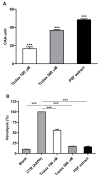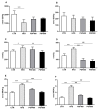Wild Italian Prunus spinosa L. Fruit Exerts In Vitro Antimicrobial Activity and Protects Against In Vitro and In Vivo Oxidative Stress
- PMID: 31861742
- PMCID: PMC7023410
- DOI: 10.3390/foods9010005
Wild Italian Prunus spinosa L. Fruit Exerts In Vitro Antimicrobial Activity and Protects Against In Vitro and In Vivo Oxidative Stress
Abstract
Polyphenol-rich foods could have a pivotal function in the prevention of oxidative stress-based pathologies and antibacterial action. The purpose of this study was to investigate the in vitro antimicrobial activity, as well as the in vitro and in vivo antioxidant capacities of wild Prunus spinosa L. fruit (PSF) from the southeast regions of Italy. The total phenolic content (TPC) was quantified, and the single polyphenols were analyzed by HPLC-DAD, showing high rutin and 4-hydroxybenzoic acid levels, followed by gallic and trans-sinapic acids. PSF extract demonstrated antimicrobial activity against some potentially pathogenic Gram-negative and Gram-positive bacteria. Besides, we investigated the cellular antioxidant activity (CAA) and the hemolysis inhibition of PSF extract on human erythrocytes, evidencing both a good antioxidant power and a marked hemolysis inhibition. Furthermore, an in vivo experiment with oxidative stress-induced rats treated with a high-fat diet (HFD) and a low dose of streptozotocin (STZ) demonstrated that PSF has a dose-dependent antioxidant capacity both in liver and in brain. In conclusion, the wild Italian Prunus spinosa L. fruit could be considered a potentially useful material for both nutraceutical and food industries because of its antioxidant and antimicrobial effects.
Keywords: antimicrobial; antioxidant; blackthorn; phenolic compounds; wild Italian Prunus spinosa L. fruit.
Conflict of interest statement
No conflict of interest was reported by the authors.
Figures




Similar articles
-
The Effect of a High-Protein Diet Supplemented with Blackthorn Flower Extract on Polyphenol Bioavailability and Antioxidant Status in the Organs of C57BL/6 Mice.Nutrients. 2023 Sep 20;15(18):4066. doi: 10.3390/nu15184066. Nutrients. 2023. PMID: 37764849 Free PMC article.
-
Phenolic Composition, Antioxidant, Anti-Enzymatic, Antimicrobial and Prebiotic Properties of Prunus spinosa L. Fruits.Foods. 2022 Oct 20;11(20):3289. doi: 10.3390/foods11203289. Foods. 2022. PMID: 37431036 Free PMC article.
-
Bioactivity Potential of Prunus spinosa L. Flower Extracts: Phytochemical Profiling, Cellular Safety, Pro-inflammatory Enzymes Inhibition and Protective Effects Against Oxidative Stress In Vitro.Front Pharmacol. 2017 Oct 11;8:680. doi: 10.3389/fphar.2017.00680. eCollection 2017. Front Pharmacol. 2017. PMID: 29085295 Free PMC article.
-
Antioxidant Activity of Blackthorn (Prunus spinosa L.) Fruit Extract and Cytotoxic Effects on Various Cancer Cell Lines.Medeni Med J. 2019;34(3):297-304. doi: 10.5222/MMJ.2019.87864. Epub 2019 Sep 27. Medeni Med J. 2019. PMID: 32821452 Free PMC article.
-
Role of Natural Antioxidant Products in Colorectal Cancer Disease: A Focus on a Natural Compound Derived from Prunus spinosa, Trigno Ecotype.Cells. 2021 Nov 26;10(12):3326. doi: 10.3390/cells10123326. Cells. 2021. PMID: 34943833 Free PMC article. Review.
Cited by
-
Assessment of the Antioxidant and Hypolipidemic Properties of Salicornia europaea for the Prevention of TAFLD in Rats.Antioxidants (Basel). 2024 May 12;13(5):596. doi: 10.3390/antiox13050596. Antioxidants (Basel). 2024. PMID: 38790701 Free PMC article.
-
Effects of Extraction Process Factors on the Composition and Antioxidant Activity of Blackthorn (Prunus spinosa L.) Fruit Extracts.Antioxidants (Basel). 2023 Oct 23;12(10):1897. doi: 10.3390/antiox12101897. Antioxidants (Basel). 2023. PMID: 37891976 Free PMC article.
-
The Effect of a High-Protein Diet Supplemented with Blackthorn Flower Extract on Polyphenol Bioavailability and Antioxidant Status in the Organs of C57BL/6 Mice.Nutrients. 2023 Sep 20;15(18):4066. doi: 10.3390/nu15184066. Nutrients. 2023. PMID: 37764849 Free PMC article.
-
Antibacterial Effect of Ethanolic Extracts of Dodonaea viscosa L. Jacq. and Mammea americana L. against Staphylococci Isolated from Skin Lesions.Biomed Res Int. 2023 Sep 4;2023:5584412. doi: 10.1155/2023/5584412. eCollection 2023. Biomed Res Int. 2023. PMID: 37700878 Free PMC article.
-
Characterization of Antioxidant and Antimicrobial Activity and Phenolic Compound Profile of Extracts from Seeds of Different Vitis Species.Molecules. 2023 Jun 22;28(13):4924. doi: 10.3390/molecules28134924. Molecules. 2023. PMID: 37446586 Free PMC article.
References
-
- Bhaskarachary K., Sudershan R.V., Subba Rao M.G., Apurva Kumar R.J. Traditional foods, functional foods and nutraceuticals. Proc. Indian Natn. Sci. Acad. 2016;82:1565–1577.
-
- Grochowicz J., Fabisiak A., Nowak D. Market of functional food—legal regulations and development perspectives. Zesz. Probl. Postepow Nauk Roln. 2018;595:51–67. doi: 10.22630/ZPPNR.2018.595.35. - DOI
-
- Veličković J.M., Kostić D.A., Stojanović G.S., Mitić S.S., Mitić M.N., Ranđelović S.S., Ðorđević A.S. Phenolic composition, antioxidant and antimicrobial activity of the extracts from Prunus spinosa L. fruit. Hem. Ind. 2014;68:297–303. doi: 10.2298/HEMIND130312054V. - DOI
-
- Pinacho R., Yolanda Cavero R., Astiasarán I., Ansorena D., Calvo M.I. Phenolic compounds of blackthorn (Prunus spinosa L.) and influence of In Vitro digestion on their antioxidant capacity. J. Funct. Foods. 2015;19:49–62. doi: 10.1016/j.jff.2015.09.015. - DOI
LinkOut - more resources
Full Text Sources

